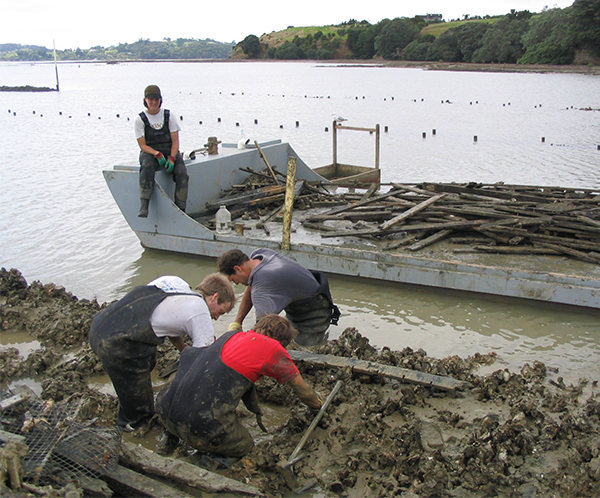That sublime feeling: My work here is done

Five Thousand Tonnes and Counting: Material is accumulating far faster than can be removed manually by annual voluntary effort. photographer Jim Dollimore
I just had to call Shane Hartley.
Fortunately for Shane he was on the phone, so I had to contain my excitement and write an email. Others hadn’t been quite so lucky that afternoon and quite a lot of phone time was spent reporting an historic breakthrough:
The 33-year-old dream of Friends of the Mahurangi founding chairman John Male, of a plan for the Mahurangi, appears to now be materialising.
The spark that ignited this is Peter Thompson’s vision of building a purpose-designed barge by which the river would be dredged to restore navigability, particularly in honour of the Jane Gifford.
The meeting that produced the excitement arose from the opportunity to use Mahurangi Action Plan focus to break the impasse over derelict oyster leases. Oyster farming pioneer and industry leader, Jim Dollimore, supported and paid for a display advertisement that I had suggested for the one and only glossy edition of the Mahurangi Magazine. The purpose was to provide a statement of the local growers’ determination to help deal decisively to the derelict lease situation. We particularly wanted to be able to say to the Auckland Regional Council:
We have stated our intent, now we must deliver.
It worked. It was almost surreal to see the discussion table dominated by copies of the Mahurangi Magazine opened at the beautiful but disquieting double-page spread.
New Mahurangi Action Plan project leader Kim Morresey, who helped convene the meeting sees the project as potentially capable of drawing in wider community support for the Mahurangi Action Plan. She is keen to hear the ideas of local people as to what form a process might take to achieve that greater involvment.
Kim Morresey’s induction got us off to a flying start. Kim readily appreciated that the lack of physical action over the leases was tarnishing, particularly for adjoining property holders, the good work of the Mahurangi Action Plan.
The plan is to identify an area that can usefully and safely absorb the material from ongoing river dredging. Then, for the first work of the operation to be remove some 5000 m³ of mud, oyster shell and racks from the derelict leases. It would make the Mahurangi marine farms possibly the tidiest in Aotearoa. It is a bold plan but without a practicable, economic means of removing and disposing of the offending material, it was most unlikely that local, regional or central government would ever find the funds to magic this all away for us.
Meantime, the contentious question of retrospective bonding of oyster leases was worked through. A comprehensive, failsafe model had been developed. I suspect that Jim Dollimore deserves a knighthood for his part in this! Too complex to elucidate here but it ensures that the responsible growers are not now penalised for those that were allowed, before it became a regional council responsibility, to bring the industry into disrepute.
So together, we begin to weave a Mahurangi vision and strategy as we pull together the dreams that already exist, while providing an ever-richer environment for new dreams to develop. We ensure that the Mahurangi Action Plan, rather than being confined to riparian restoration, is integrated into a holistic approach with similarities to the groundbreaking Waitakere Ranges Heritage Area process.
And now, of course, the real work begins.
Footnote Shane Hartley of Terra Nova Planning was, when I first met him, Rodney District Council head town planner. He has kindly helped our organisation on a number of occasions. He is one of many who donates professional support because ‘the Mahurangi is my special place’.
